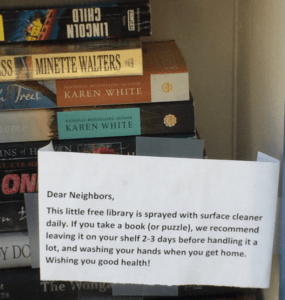
Social distancing does not mean communications distancing
I’ve already written encouraging you to ask supporters for help. Right NOW. This is a time people are actively looking for ways to make a difference. IMHO it’s almost criminal not to offer would-be philanthropists an opportunity to be a hero. And your mission doesn’t have to be engaged in what’s commonly considered a ‘frontline response’ or ‘essential.’ In other words, you don’t have to be directly engaged in COVID-19 prevention, mitigation or treatment.
Your mission matters! It mattered yesterday, right? That hasn’t changed. People still want to save the environment… rescue puppies… increase child literacy… listen to music… preserve architecture… help kids go to college.
Don’t go dark on folks when they most need to hear from you. Whatever your cause, your constituents deserve to hear from you about how this pandemic is affecting you and all those who rely on you. If you really don’t need donor support right now (perhaps thanks to a large endowment or huge ‘rainy day’ reserve), then… fine. Don’t send a fundraising appeal. I’m guessing, however, for most of you reading this article YOU DO NEED CONTRIBUTIONS to keep you afloat.
Since you need income now, your best communication bet for other than major donors is online. [With major donors you can set up a virtual visit or simply pick up the phone and talk to them.] For everyone else, digital is your best bet. Snail mail is too slow for crisis fundraising, plus some folks won’t have stamps at home or won’t want to go out to the mailbox right now. So… let’s take a look at how to put together a successful online crisis appeal.
UPDATE: My friend, direct mail guru Eric Waasdorp, tells me she’s actually been having good success with snail mail these days. Print shops and mail houses are apparently considered ‘essential businesses’ and are able to get you on their schedule faster than usual. Plus the post office can use the business. I stand corrected! Just remember there will still be folks out of stamps, so be sure to include your website donation page link in case they want to give online.]
Sloppy Online Fundraising is Just That
Even during ‘ordinary’ times nonprofits often spend oodles of time crafting a mailed letter; then slap an e-appeal together as an afterthought. Not a good idea. Not ever. There’s a formula that works, and you want to adhere to it. The same holds true for website appeal copy and donation landing pages. Often these tasks are farmed out to the marketing or IT staff. And, generally, it’s not in their job description to consider things from the donor’s perspective.
If your messaging comes across as fuzzy or slap-dash, guess what the likely response to your appeal will be? I can promise you it won’t be great. When that happens, you or your stakeholders may erroneously conclude it was because now is a bad time to fundraise. Nope. It’s a bad time to be sloppy about how you fundraise.
Right now, you may be faced with having to fundraise without the staff upon whom you usually rely. Maybe you’re the executive director or development director who’s never had to write an online appeal, let alone design and launch it. You’ve still got no excuse to (1) be missing in action, or (2) be sloppy about the messaging you send out.
You simply need to be aware of, and avoid, these three crisis appeal mistakes.
1. Unplanned vs. Templated Email Structure

Great Planning. Great Clarity.
Wing and a prayer is never a good strategy. Rather than throw spaghetti out there to see if it sticks, how about simply writing an appeal that includes, succinctly, the following four elements? This is actually a condensed version of my basic ‘Clairification’ template for any appeal.
1. Clairify the urgency.
Folks need to know why you’re asking now, and why they should give immediately. This is why year-end appeals sometimes highlight the tax deduction deadline or indicate you’ve only got X days left to meet the matching grant challenge. With crisis appeals, urgency doesn’t need to be manufactured. If you’re going to have to fire staff… cut back on programs and services… risk shutting down entirely… you’ve got all the urgency you’ll need. Don’t hide it. This is no time to pretend it’s ‘business as usual.’ It’s likely not, your donors don’t expect it to be, and they really want to know what’s up. For once they won’t think poorly of you if you’re having trouble balancing your budget.
I don’t normally send you emails like this … but these are desperate times.
As you can imagine, people are calling on us like never before for (food, shelter, counseling, caregiver assistance, domestic abuse prevention, etc.) and we need emergency donations so we can meet increased demand.
I never wanted to send a letter like this but, if something doesn’t change right away, we’re going to have to shut our doors.
Get straight to the point.
2. Clairify the downside you’re experiencing.
Be specific. Don’t just say “times are tough; we need money.” What, precisely, can the donor help you with? Your budget shortfall? Your ability to pay salaries and continue health insurance? Your ability to continue to help those who rely on you who are suffering? Your ability to ramp up your assistance because it’s needed now more than ever?
We expect earned income to be down 85% due to the fact we’ve cancelled most of our programming through the end of May. That means $2.5 million in lost revenue.
We anticipate contribution income to be down 20% because some of our donors are also experiencing unanticipated hardship. And we had to cancel our spring fundraising event. Combined, that’s $400,000 in lost revenue
Be clear what contributions will be used for.
3. Clairify what you’re asking for.
It’s always best to make a request for a specific amount and specific purpose. This helps the donor visualize how their gift will be used. It exudes authenticity and inspires a sense of trust. You’re not just asking for money you’ll use for who knows what. You’re asking for a solution to a demonstrated problem. One the donor can heroically solve – simply by giving you an amount they don’t have to guess at.
Please respond to this urgent request with a gift of $XX to provide (fill in the blank).
Donors like you are responding to this urgent request with gifts averaging $XXX; will you please consider a similar contribution?
We’ve created a ‘Coronavirus Resiliency Fund’ to assure our ability to continue paying staff, provide health benefits, pay rent and insurance and ramp up our activities in key areas where demand has exploded.
4. Clairify how the donor can give.
Make it easy and obvious. Your best bet is a noticeable button both at the top and bottom of the appeal. When folks click on it, it should take them to a user-friendly donation landing page. This page should be dedicated to your appeal. In other words, it should be headlined something like “Coronavirus Emergency Response” and be clear how the donor’s gift will be used. The language should match the language of the appeal. If you send donors to your generic landing page, it will confuse them at best and turn them off at worst. Trust me, many a donation has been lost betwixt the ‘donate button’ and the landing page. Never forget your landing page is as much a part of your appeal as any other component.
2. Above vs. Below the Scroll

Works for a window; not a web appeal
Think carefully about what your donor sees first. (1) This begins, of course, with your email subject line. (2) It continues with whatever text is displayed in their email preview pane. Spend some time carefully crafting these. [See examples here, here and here.] (3) Finally, it continues with what your donor sees at the top of the page. If there’s no ask and no donation button above the fold, you’ve pretty much killed your chances of this appeal being a success.
Above the fold is a concept. It’s borrowed from newspaper terminology when the most important articles appeared, literally, above the fold. It’s a bit trickier online, where ‘the fold’ is that which falls below what the user sees on their screen without scrolling on the page. Alas, screen sizes are different and your email won’t display the same on all of them. When you’ve got the bandwidth, and experienced staff to help you, it’s a good idea to test how your message displays on different devices using different browsers. For now, stick with this truism: You want the important stuff on top – where the donor is sure to see it!
Users don’t scroll for fun; they scroll for a purpose. You’ve got to make them want to keep reading. Why? Because scrolling is work! People don’t like to work if they don’t have to. It’s your job to do something that will make them conclude it’s worth their time and effort to scroll down.
This advice applies to email appeals, donation landing pages and just about everything people view on a screen. And what people view affects the actions they take, or don’t take. Eye-tracking studies reveal the 100 pixels just above the fold are viewed 102% more than the 100 pixels just below the fold. What’s more, what viewers see vs. what’s hidden below hugely influences their behavior – by a factor of 84%! It’s definitely not a bad idea to offer a glimpse of engaging content or imagery at the bottom of your above-the-fold content. You can drive folks downward by using good design, including:
- Engaging content
- Engaging imagery
- Engaging page structure
3. Inviting vs. Uninviting Web Page Design

Be sure what you want folks to see will be where they’ll look
You need to know eye-tracking research shows people tend to read online in an F-pattern. If your important content isn’t found here, folks may miss it (just like they’ll miss content you locate below the scroll). And… they won’t know what they missed.
What does this mean? The folks at Neilson Norman Group, who specialize in User Experience, have developed research since 2006 that consistently shows people scan webpages and phone screens in various patterns, one of them being the shape of the letter F. People do this unconsciously – and they won’t know what they missed! Nor will you. Instead, you may erroneously conclude that fundraising right now is a bad idea. Nope. The design was a bad idea.
The good news is good design can minimize the negative effects and/or prevent F-shape scanning.
Here is what the F-pattern means:
- Readers’ eyes concentrate on the top and left-hand part of the page.
- Readers begin with the top line of text, reading across horizontally (top bar of ‘F’).
- Readers next move to the next line, reading across horizontally, typically for a shorter amount of time (second bar of ‘F’).
- Finally, readers scan the remaining content in a left-side downward vertical movement (stem of ‘F’).
Note the F-shaped pattern applies to the content area of the web page, not the navigation bar (be it at the top or left-hand side of the page, which is typical). And the F-pattern applies equally to desktop and mobile access of your content. Interestingly, the research shows that in right-to-left languages such as Arabic, people read in a flipped F-shaped pattern.
Complicating your job is the fact that responsive design means text will flow differently depending on device. A reader who accesses your appeal on a phone may not fixate on the same words as the reader who finds you on a desktop. So you have to consider both in crafting your appeal. This is why development and marketing and IT all need to collaborate. Silos don’t work. Not for you. Not for your users.
This stuff isn’t easy, but it’s important as all get out.
I’m guessing you and your team work really hard developing text, selecting images and laying things out on the page. I implore you not to let all your hard work go to waste by skipping the final, critical step of assuring your appeal will be read and your desired action response will be placed where it’s sure to get noticed.
You have two choices if you want folks to notice your most important content:
- Put most important content in the ‘F’ default area readers will use when there are no strong cues to attract them elsewhere.
- Create strong cues to attract readers’ eyes elsewhere, where your most meaningful visuals and information lies.
Final Thoughts
Do your best to avoid these three mistakes. I know you may not be able to optimize all of these recommendations right now, but at least be aware of how you’re crafting your message and how your reader will perceive it.
Remember the role you’re filling and why you’re filling it. Perhaps you’re not used to thinking about these things much at all, because they’re usually the province of your marketing or communications manager. And you? You’re the fundraiser. The two functions of marketing and fundraising should be inextricably linked; sadly, they often are not.
It’s part of your job as fundraiser to make sure your fundraising messages stand a fighting chance of being opened, read and acted upon! Do not leave this in the hands of someone else. While you may not have the digital and/or design skills to implement all the advice I’m sharing, you can certainly consult with your co-workers and/or volunteers and let them know about the wisdom you’ve sourced.
Finally, once you done all this work please send your email again. And again. And again. Frankly, I believe you can easily send a weekly fundraising email right now because… this is a crisis! And email is a funny critter. People open right away, or the email falls to the bottom of the inbox never to be seen. Don’t let your work go to waste! Just put something in your message that thanks folks who’ve already responded. This way they won’t be annoyed, and some will even give another gift.
Remember… your donors love you!
Want More Help Crafting a Compelling Appeal?
 Grab my Anatomy of a Fundraising Appeal + Sample Template. It’s a 62-page comprehensive step-by-step e-guide to crafting a killer appeal letter or email appeal. I promise you’ll learn a lot, and emerge much more confident in your task at hand.
Grab my Anatomy of a Fundraising Appeal + Sample Template. It’s a 62-page comprehensive step-by-step e-guide to crafting a killer appeal letter or email appeal. I promise you’ll learn a lot, and emerge much more confident in your task at hand.
No satisfied? No worries. All Clairification products come with a 30-day, no-questions-asked, 100% refund guarantee. If you’re not happy, I’m not happy.
Photos are my own, taken on my social distancing neighborhood walks.
-
Pingback: Coronavirus & Nonprofits: Resources for Responding to COVID-19 - Wired Impact




